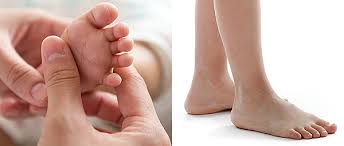Shoes off kids…please!

Our ancestors did not wear “stable shoes with lots of support”. In fact until recently, on the evolutionary timeline that is, humans didn’t wear shoes at all. Regular use of shoes is a ‘recent’ trend. And the further humans deviate from what they were naturally selected to do…the more their health suffers.
I first became fascinated with going barefoot after reading Christopher McDougall’s book born to run in 2009. My quick synopsis of the book is at the end of this article for those interested. His book sparked immediate change and skepticism of an industry built on marketing “supportive and cushioned” running shoes. Organizers of the 2010 New York City Marathon noted a dramatic increase in participants wearing minimalist (minimal support) shoes. Demand for minimalist shoes subsequently exploded and running shoe manufacturers pivoted towards providing more minimalist shoe options.
I went minimalist (remember the Vibram 5 finger craze??) and if you were a patient of mine in 2009 or 2010 I likely recommended you go minimalist as well. I continue to wear minimalist shoes the majority of my day. I love going about my day in what essentially feels like the comfort of a slipper.
However, I have come to appreciate that minimalist footwear is not for everyone. And I learned the hard way: my recommendations hurt some of my patients. Adults who were wearing fully supportive and heavily cushioned shoes for decades all of a sudden ditched their thick soled runners and (not surprisingly in retrospect) either aggravated old injuries or developed new injuries. This was simply too much of a change, too quickly. Going barefoot as an adult is a complex, nuanced and highly individualized decision.
There is one group of our population however that can universally benefit from being barefoot as much as possible: children.
Our children don’t have the disadvantage of years of various (often poor) footwear choices complicating the issue. The early years are formative for our children for many reasons, and musculoskeletal development is no exception.
A group of German and South African researchers are beginning to shed more scientific light on the negative impact of our children wearing shoes. The researchers have collected data from over 800 subjects comparing children and adolescents from rural Western Cape South Africa where children are primarily barefoot to children and adolescents in urban Germany who wear shoes most of the time.
Key findings from this research published in 2017 indicate that South African children and adolescents have a higher arch, with more pliability of the foot and increased toe angulation. The long term effects are not entirely clear at this point, but structurally the foot does appear to develop differently.
The same researchers found that children and adolescents who spend most of their time barefoot also develop motor skills differently from those who habitually wear shoes. When tested the habitually barefoot group scored significantly higher in balance and jumping tests. So functionally kids benefit from ditching the shoes as well.
Our children’s feet constantly acquire information from their contact with the ground. When barefoot they have a sensory rich experience that helps better prepare them for future similar exposures. We should encourage challenging our children to a variety of tasks, on a variety of surfaces, so their feet can adapt appropriately to these stresses. So let them run, jump, play and explore inside and outside barefoot as much as possible.
This is certainly a bit of a stretch from the current research, but in my opinion if you want your child:
-to have strong feet, with good balance and body awareness
-to have healthy feet with a reduced risk of injury
-to have a greater connection to our earth
GO BAREFOOT.
Next time your child is running outside to play change your default parenting line from “shoes on please” to “shoes off please”!
There are of course many situations outside of the home, yard and playground where children are required to have something on their feet…and to that I say, choose wisely.
Children’s shoes should have soles that are thin, flat (no extra cushioning at heel), wide in the toe box (front of the shoe) and highly flexible.
For infants and toddlers a couple options for soft soled shoes: bobux and soft star.
Beyond the toddler stage it gets harder to find good minimalist shoe options for kids. Vivo has great options for all ages, with several different styles (many of which we have tried). Buyer beware of sticker shock!
Side note: Pete and I wore Vivo’s for a couple years and then stumbled upon Xero. The shoes feel different (but not inferior) and have proven just as durable as Vivo in our experience. Although Xero has significantly less selection of styles and colours they come with a much more palatable price tag. Unfortunately they don’t have kid options yet.
My quick synopsis of Born to Run:
In Born to Run Christopher McDougall asserts that the Tarahumara Native Mexican Tribe who were known to run ultra distances at incredible speeds without getting the routine running injuries, were able to do so because they ran in only thin sandals. They hadn’t been exposed to a running shoe industry that had inadvertently contributed to injuries like plantar fasciitis, anterior knee pain and iliotibial band issues by making thick supportive cushioned shoes.
